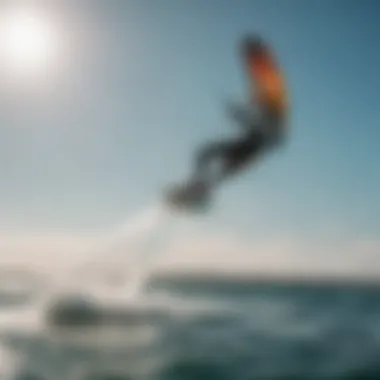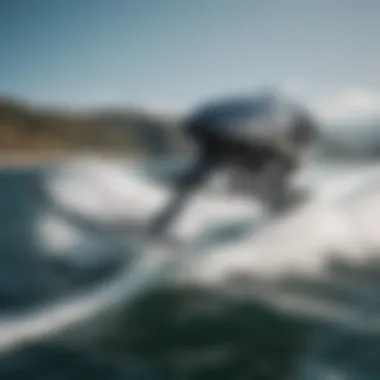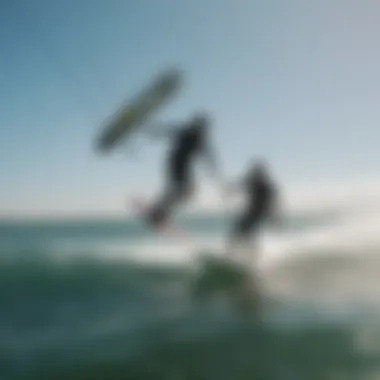Hydrofoiling in Kiteboarding: A Deep Dive


Intro
Hydrofoiling has been making waves – literally and figuratively – in the kiteboarding world. This innovative approach to kiteboarding has opened up a realm of possibilities for enthusiasts. Picture this: gliding effortlessly above the water, catching wind as you soar above the surface. It feels like flying! Hydrofoiling transforms the traditional kiteboarding experience, combining a unique set of gear and techniques that set it apart.
Whether you’re a seasoned kiteboarder or a newbie eager to get your feet wet, it's crucial to grasp the fundamentals that drive this exciting sport. From gear selections to mastery of techniques and safety practices, understanding hydrofoiling can elevate your kiteboarding exploits substantially.
This article aims to traverse the depths of hydrofoiling in kiteboarding. We’ll dig into the intricacies of gear, unveil vital safety tips, discuss techniques utilized by professionals, and spotlight striking locations that boost the hydrofoiling experience. Together, let’s unlock the secrets to smooth sailing on your hydrofoil, while also nurturing a community rooted in shared knowledge of this thrilling pastime.
Gear Insights
Latest Gear Reviews
As the hydrofoiling scene continues to grow, so does the range of gear available for both novices and experts. Here’s a rundown of some of the latest equipment that’s worth taking a closer look at.
- North Foil: Renowned for its high-quality construction and stability. It's responsive, making it a favorite among advanced riders.
- Slingshot Manta Foil: This foil is outstanding for its versatility, catering to both beginners and seasoned experts alike. The design allows for smoother cruising.
- Liquorice Foiling Kite: This kite is gaining traction for its fantastic upwind performance and consistent lift during those exhilarating moments.
Many kiteboarders rave about the advancements in gear, enabling riders to make smoother transitions and manipulate their speed, maximizing performance.
Essential Gear for Beginners
For those just starting out, selecting the right gear is crucial. You don’t want to be in over your head, literally and figuratively! Here’s a quick guide tailored for beginners:
- Foil Board: Look for a board that’s stable and designed specifically for learning. Wider boards offer greater stability, making it easier to find your balance.
- Kite Size: Choosing the right kite size according to your weight and local wind conditions is essential. Generally, beginner kits should focus on larger kites as these are more forgiving in low winds.
- Safety Gear: Never skimp on safety gear. A helmet and impact vest are vital to protect yourself, particularly when learning.
"The right equipment makes all the difference. It's not just about the ride; it's about enjoying the journey toward mastery."
Techniques and Tips
Advanced Tricks and Techniques
Once newcomers have gained a grip on the basics, the allure of advanced tricks beckons. Here are a few moves to aspire towards:
- Toeside Riding: This technique allows you to ride without changing stance, offering smooth transitions and control.
- Backrolls: Executing backrolls gives you a flashy and stylish edge, and mastering this trick opens doors to even more complex rotations.
- Jump with a Toeside Takeoff: This jump increases the thrill factor and demonstrates skill combined with finesse.
Safety Practices for Kiteboarders
Safety in hydrofoiling cannot be overstated. It’s crucial to remember that conditions out on the water can change rapidly. Here are some essential safety practices:
- Know Your Environment: Stay aware of wind patterns, currents, and any restricted zones. Navigation skills can prevent accidents.
- Check Your Gear: Prior to hitting the water, inspect all equipment for any wear or damage. This simple act can save you from unnecessary risks.
- Maintain Distance from Others: Always be considerate of fellow kiteboarders. Keeping a safe distance helps avoid collisions.
As our exploration of hydrofoiling unfolds, keep these insights in mind to elevate your skills and enhance your overall kiteboarding adventure.
Prelims to Hydrofoiling
Hydrofoiling marks a transformative chapter in the world of kiteboarding, where water sports enthusiasts can truly elevate their experience. This innovation doesn’t just add flair; it fundamentally alters how participants engage with the wind and sea. Understanding the nuances of hydrofoiling opens up a broader horizon for both novice and seasoned kiteboarders.
Defining Hydrofoiling
At its core, hydrofoiling is a technique where a kiteboarder rides above the water surface on a specialized board attached to underwater wings called hydrofoils. Imagine slicing through waves with less resistance, akin to a bird soaring effortlessly through the sky. This sleek setup allows for a reduced drag effect, enabling riders to glide above the water with minimal effort. Instead of battling against the pull of the waves, hydrofoil riders experience a sensation that is almost like floating, where the board lifts them above water, enhancing their speed and enjoyment.
It's essential to grasp that hydrofoils consist of two main components: the mast and the wings. The mast connects the board to the wings below the surface, while the wings create lift. As speed increases, the lift generated counteracts gravity, allowing the board to rise. This motion is a remarkable feat of engineering that puts riders in a unique position to exploit wind power efficiently.
The Importance of Hydrofoiling in Kiteboarding
Hydrofoiling has gained traction in kiteboarding because of its unparalleled advantages. First off, it extends the riding season. Where traditional kiteboards may struggle in lower wind conditions, hydrofoils glide smoothly even with lighter breezes. This flexibility opens up kiteboarding to a wider array of environments and allows for longer sessions without being dependent on optimal wind conditions.
Moreover, hydrofoiling encourages a different style of riding. Riders often find that they can navigate through choppy waters more easily, which may be daunting in a standard setup. This makes hydrofoiling particularly appealing to adventurers who seek to explore various coastal landscapes. Additionally, the thrill of lifting off and feeling the rush while hovering above the waves adds an element of excitement that traditional kiteboarding cannot replicate.
In essence, hydrofoiling does not simply enhance the kiteboarding experience; it revolutionizes it. As the sport continues to evolve, embracing hydrofoiling can lead participants to new adventures and deeper connections with the water. Riders can engage in a zesty blend of challenges and rewards, finding every session on the water fresh and exciting.
"Embracing hydrofoiling is like unlocking a new level in kiteboarding—where every ride can feel like an adventure waiting to unfold."
With this foundation laid, the subsequent sections delve into the mechanics of hydrofoiling and how it then influences various aspects of kiteboarding—making this a worthy pursuit for anyone looking to elevate their game.
The Mechanics of Hydrofoiling
Hydrofoiling in kiteboarding isn’t just a fancy add-on; it's a fundamental shift in how enthusiasts interact with the water. Understanding the mechanics behind it is crucial for kiteboarders aiming to harness the full potential of their gear. When we delve into this aspect, we’re not just looking at how foils lift and glide, but also at how these principles can enhance performance and enjoyment on the water.
How Hydrofoils Work
The functionality of hydrofoils can be boiled down to two primary elements: lift generation and drag reduction. These two factors intertwine to create the exhilarating experience that kiteboarders seek.
Lift Generation
Lift generation is where the magic starts. At its core, lift is produced when water flows over the surface of a foil, creating a difference in pressure between the top and bottom surfaces. This phenomenon is akin to how airplanes achieve flight via their wings. The shape and angle of the hydrofoil significantly influence its lift capabilities. A well-designed hydrofoil can lift a rider above the water’s surface, reducing drag and improving speed.
One of the key characteristics of lift generation is its ability to produce a stable ride. Riders are left to experience less turbulence, allowing for a smoother glide. This feature makes lift generation an advantageous choice for kiteboarders looking for high-speed performance. Moreover, lift generation allows riders to face varying wind conditions without losing momentum, which is critical during longer sessions on the water.


However, it's important to note that lift generation doesn't come without its challenges. For starters, too much lift at high speeds can lead to instability, causing a rider to lose control, particularly during turns. Finding that sweet spot in lift is essential for safety and performance.
Drag Reduction
Next up is drag reduction, which plays an equally vital role in the success of hydrofoiling. Essentially, drag is the resistance that occurs when the board or foil moves through the water. Reducing drag means that the rider can maintain speed with less effort, conserving energy for more enjoyment on the water.
The key characteristic of effective drag reduction lies in the design of the hydrofoil. A streamlined shape minimizes the water resistance, allowing for quicker speeds and less tiring rides. Furthermore, with lower drag, riders can perform tricks and maneuvers with greater ease because they spend less time fighting against the water.
That unique feature of smooth, effortless acceleration can be a game-changer for many kiteboarders. It's not just about going fast; it's about optimizing each ride. The downside? Poorly designed or misconfigured hydrofoils can exacerbate drag, potentially slowing down a rider's experience.
Comparison with Traditional Kiteboarding
When we compare hydrofoiling to traditional kiteboarding, the differences become glaringly apparent. Traditional setups involve a board that stays flat on the water, leading to increased drag and a different kind of ride experience.
With hydrofoiling, one can achieve a feeling of floating above the surface, changing how kiteboarders feel the wind and water. Riders often describe hydrofoiling as having more freedom, akin to laceing up a pair of ice skates after being accustomed to heavy boots.
In summary, understanding the mechanics of hydrofoiling isn’t just for the gearheads; it’s essential knowledge for anyone looking to elevate their kiteboarding game. Familiarity with how lift generation and drag reduction work can equip riders with an informed perspective that can lead to enhanced performance and, most importantly, a more rewarding experience on the water.
The Evolution of Hydrofoiling
Understanding the evolution of hydrofoiling is essential for grasping how the sport has transformed over the years. Its history sheds light on the trials, advancements, and changing perspectives within kiteboarding. With each shift, hydrofoiling has brought new possibilities, attracting a wider audience while enhancing the experience for seasoned riders. Many enthusiasts find inspiration in learning the past, recognizing that a solid foundation leads to joyful exploration in the present and future.
Historical Overview
Hydrofoiling took its first breaths in the early 20th century, with the concept gaining traction through various water sports. The pioneering days featured wooden structures that barely skimmed the surface of water, but those early scuba-like designs hinted at the potential of hydrofoils. Over decades, innovators tirelessly refined these rudimentary designs, integrating materials like aluminum and carbon fiber. By the late 90s and early 2000s, hydrofoiling began making strides into kiteboarding, marking a watershed moment.
As enthusiasts embraced it, the sport evolved dramatically, bridging gaps between different styles of riding. This period saw a gradual rise in popularity, driven by influential figures and their passion for pushing the limits. Iconic events and competitions flourished, showcasing the emerging discipline. With every leap, ground swells of interest captivated audiences, inspiring a whole new generation of kiteboarders.
Modern Developments
Innovative Designs
Today’s hydrofoil designs are admired for their sophistication. One of the key characteristics is the shape of the wings, which have been tailored to optimize lift while minimizing drag. This evolutionary leap offers a blend of efficiency and stability, making it more accessible for riders of different skill levels. Notably, the popular fuselage design allows users to adjust the height from the board, contributing to a customizable experience.
A unique feature in many modern hydrofoils is the modular aspect, allowing users to mix and match components like wings and masts to tailor their gear to conditions and riding styles. While these designs enhance performance, they also present certain challenges, such as increased complexity in assembly and initial setup for novices. Yet, their advantages — swift performance and a smoother ride — make them a sought-after choice among serious kiteboarders.
Technological Advances
Innovative materials have also changed the game, keeping the sport at the cutting edge. The emphasis on lightweight construction marries durability with performance, encouraging riders to push the envelope further. A standout characteristic of modern technological advances is the incorporation of hydrodynamic analysis software, enabling manufacturers to simulate how new designs will perform before they hit the water.
The unique feature of using advanced composites allows for lighter, stiffer foils, improving responsiveness during tricky maneuvers. Though such technologies often come with a higher price tag, many athletes rationalize the investment as they enhance their performance potential. As technology marches on, it becomes apparent that today's innovations lay the groundwork for what’s still to come in the dazzling world of hydrofoiling.
Choosing the Right Hydrofoil Gear
Selecting the appropriate hydrofoil gear is crucial for maximizing performance and safety while kiteboarding. The right equipment not only enhances the overall experience but also impacts functionality and skill development. Considering various elements such as foil size, shape, and board selection allows riders to tailor their choices according to their personal preferences and riding styles. In the world of hydrofoiling, having gear that aligns with one’s goals is key to unlocking the sport's full potential.
Essential Components of Hydrofoil Gear
Foil Size and Shape
Foil size and shape can significantly influence a rider's experience on the water. The size mainly refers to the surface area of the foil, which affects lift and drag characteristics. A larger foil generally provides more lift at lower speeds, making it a good option for beginners or those who want comfort in tricky water conditions. Conversely, smaller foils are suited for advanced riders seeking speed and agility.
Key Characteristics: The shape of the foil affects how water flows over it, which is crucial for performance. A thicker profile might create more drag but provides stability, while a thinner foil allows for faster speeds with less resistance.
Unique Features: The specific design of foils, like the aspect ratio, should be taken into account; higher aspect ratio foils produce less drag at higher speeds.
Advantages/Disadvantages: In this article, understanding these attributes helps readers to choose wisely. While bigger foils can be beneficial for early-stage learning, they might not be suitable as riders progress and desire more dynamic maneuvers.
Board Selection
Choosing the right board is equally vital as it complements the hydrofoil setup. The board's size, width, and material can change the feel and performance. Wider boards provide more stability during flights, particularly for beginners. Additionally, a shorter board can allow for quick turns and sharper performance suited to advanced riders who know how to handle the variability of their surroundings.
Key Characteristics: Material plays a significant role in board choice. Lightweight materials can enhance performance but might affect durability in rough conditions.
Unique Features: Also, a count of foot strap inserts indicates how well the board can adapt to different riding styles, making it customizable for user preference.
Advantages/Disadvantages: Understanding these details equips aspirants with the necessary knowledge to avoid common pitfalls. A mismatched board can lead to a frustrating experience, hindering progression and enjoyment in this exhilarating sport.
Top Brands and Products
When it comes to hydrofoiling gear, several brands stand tall alongside their respective products.
- Slingshot is renowned for its innovative designs and solid construction that appeals to both beginners and pros alike.
- Naish boasts versatility in its boards, accommodating a range of riding styles.
- Duotone stands out with its unique set-ups, making it a popular choice for kiters looking to expand their skills.
- F-One offers a selection of foils that marry performance with stability, catering to various skill levels.
With this foundation of knowledge, kiteboarders can make informed choices about their hydrofoiling gear, ensuring each ride meets their expectations and elevates their kiteboarding journey.
Hydrofoil Maintenance and Care


Taking care of your hydrofoil gear is as essential as mastering the art of riding it. Proper maintenance and care not only extend the life of your equipment but also enhance your performance on the water. After all, a well-maintained hydrofoil can make the difference between a seamless glide and a frustrating session where you’re constantly battling equipment issues.
Routine Maintenance Practices
Keeping your hydrofoil in prime condition involves a few straightforward but crucial routines. Here are some practices kiteboarders should adopt:
- Regular Inspections: Before every session, take a moment to check the foil for any signs of damage. Look for scratches, dings, or signs of corrosion. A quick visual inspection can save you from serious mishaps later.
- Cleaning: Saltwater and sand can be brutal on your gear. After each session, rinse your hydrofoil with fresh water to prevent salt buildup. Pay extra attention to fittings and areas where dirt tends to accumulate.
- Fasteners Check: Ensure that all screws and bolts are tightened properly. Vibration from riding can loosen them over time. A loose screw might seem trivial, but it can lead to larger issues while out on the water.
- Foil Pitches: Regularly check and adjust the pitch angle of the wing according to the manufacturer’s recommendations. It directly influences the lift and stability.
Adopting these simple practices not only helps to maintain your hydrofoil but also gives you peace of mind while tearing through the waves.
Storage Tips for Longevity
Where and how you store your hydrofoil can significantly impact its lifespan. Here are some storage tips to keep your gear in great shape:
- Dry and Cool Place: Store your hydrofoil in a cool, dry area. Extreme temperatures can warp the materials, especially if it’s made from composite materials. Avoid leaving it in direct sunlight for extended periods.
- Keep It Upright: Whenever possible, store the hydrofoil upright. If it lays flat on the ground, it could lead to warping or bending.
- Use Protective Covers: Invest in quality protective covers or bags when transporting or storing your foil. This safeguard protects it from physical damage and keeps dust and debris at bay.
- Disassemble When Necessary: If you’re not planning to use your hydrofoil for an extended period, consider disassembling it. Remove the wings and fuselage for easier storage, preventing any unnecessary stress on connections.
Remember: Taking the time to properly maintain and store your hydrofoil isn’t just about gear longevity; it’s about maximizing performance, safety, and enjoyment!
Safety Considerations in Hydrofoiling
Hydrofoiling offers a thrilling experience on the water, but it’s essential to prioritize safety. Understanding safety considerations in hydrofoiling helps prevent accidents and promotes responsible riding. Both seasoned kiteboarders and newcomers must be vigilant about the potential risks involved. Let’s break down some important elements that contribute to a safer outing.
Pre-Flight Safety Checks
Before hitting the water, performing thorough pre-flight safety checks is crucial. These checks ensure that all equipment is in top shape and reduce the likelihood of mishaps. Here’s a quick checklist to remember:
- Inspect the Kite: Look for any rips or tears. Make sure the lines are untangled and securely attached.
- Check the Hydrofoil: Ensure that the foil is properly assembled, with no loose parts or corrosion that could lead to failure.
- Assess the Board: Inspect the board for damage. Also, check the foot straps to ensure they're secure.
- Harness and Safety Leash: Validate that your harness is comfortable and that the safety leash is functioning properly.
- Environmental Conditions: Take a moment to evaluate wind patterns and water conditions. This includes looking out for other water users.
Engaging in these safety checks could mean the difference between a fantastic ride and a serious accident. This practice builds a habit that elevates safety, making your experience much more enjoyable.
Understanding Hydrofoiling Risks
Every thrilling sport comes with its own set of risks, and hydrofoiling is no different. Recognizing these risks helps riders make informed decisions to minimize danger.
Injury Prevention
When kiteboarding, injury prevention is at the forefront of a rider's mind. The unique aspect of injury prevention in hydrofoiling revolves around how quickly a rider can gain speed and lift above the water. As the foil lifts, maintaining balance becomes key. Here are some strategies that help:
- Proper Stance: Bend your knees and keep your weight centered to help with stability.
- Educate Yourself: Understanding the dynamics of both the kite and the hydrofoil can lead to safer maneuvers.
- Wear Protective Gear: Equip yourself with a helmet and impact vest to cushion any falls.
By integrating these practices into your routine, you can significantly reduce the chances of injury, making it a beneficial aspect of engaging in this sport. It’s an element that no kiteboarder should overlook.
Environmental Awareness
Being environmentally aware is another key consideration. Hydrofoiling interacts with nature, and understanding local wildlife and ecosystems is vital. Here’s why:
- Local Regulations: Different areas have specific regulations to protect marine life. Familiarizing yourself can save you from penalties.
- Wildlife Protection: Areas may be breeding grounds for certain species; being mindful not to disturb them fosters harmony.
- Pollution Awareness: Keeping our waters clean benefits everyone who enjoys water sports. Report any pollution or hazards as they can affect fellow riders as well as local ecosystems.
Ultimately, engaging with the environment positively enhances everyone’s experience on the water. As hydrofoilers, we are stewards of our waters and should act accordingly.
"Safety isn’t just a checklist; it’s a mindset that can keep you riding for years to come."
By emphasizing these safety considerations, practitioners at all levels can enhance their enjoyment and minimize risks associated with hydrofoiling.
Techniques for Effective Hydrofoiling
When it comes to hydrofoiling in kiteboarding, the techniques you employ can make all the difference between skimming gracefully above the water's surface and face-planting into waves. The core of effective hydrofoiling lies not just in mastering the mechanics of your gear, but also in honing the right set of skills and approaches that allow for optimal performance. Proper techniques can lead to a more exhilarating experience, reduced risks, and can really enhance your proficiency on the water. Understanding both the basics and more advanced maneuvers opens the doors to a range of impressive displays and the potential for a lifelong passion for the sport.
Basic Hydrofoiling Techniques
Starting with the basics gives anyone new to hydrofoiling a solid foundation. One of the first skills to master is the stance. Beginners should aim to maintain a centered position over the hydrofoil. This means keeping your body weight evenly distributed to avoid the foil lifting too high, which can result in instability. Here’s a breakdown of key points:
- Stance: Keep your knees slightly bent and shoulders relaxed. A low center of gravity is crucial.
- Riding Position: Leaning slightly forward as you gain speed helps keep the foil submerged.
- Speed Management: Start slow to get the feel of the lift. Gradually increase speed until you find comfort.
- Edge Control: Learn to use heel and toe edges effectively to maintain balance and direction.
Practicing these fundamentals will create muscle memory, making advanced maneuvers much easier later.
Advanced Maneuvers and Tricks
Once the basics are well in hand, the exciting journey into advanced hydrofoiling begins. This stage is where creativity and skill can shine. Advanced tricks not only add flair to your ride but also show mastery of your equipment. Here are some noteworthy techniques that can elevate your hydrofoiling experience:
- Carving Turns: Sharp turns require combining edge control with shifting your weight. Initiate the turn using your toes and shift weight to your back foot to carve smoothly.
- Jumping: To jump, you’ll need to generate speed and then compress your knees as you approach the kicker. As you take off, extend your legs and lean back to maintain stability in the air.
- Slide Tricks: Incorporating slides involves specifically targeting your rail edges. Utilize the pressure from your feet to allow the foil skimming across the water while executing your slides.
- Air Tricks: These are innate challenges—working on 180s, 360s, or even flips. Mastering air tricks requires keen timing, grip on the kite, and synchronization of your body’s core strength.
Achieving proficiency in these tricks often requires patience and hours on the water. Starting small, focusing on one trick at a time, and gradually building up skill is the best approach.
"Hydrofoiling is not just about staying above the water; it’s about finding your rhythm, dancing on the waves, and pushing the limits of what’s possible."
By progressively developing techniques, kiteboarders can enjoy a more dynamic and engaging time on the water. Whether you are a newcomer or seasoned rider, mastering these techniques will enrich your hydrofoiling journey significantly.


Popular Locations for Hydrofoiling
When it comes to hydrofoiling, the choice of location can make all the difference. Picking the right spot not only enhances the experience but also allows for more enjoyable rides. Factors like wind conditions, water quality, and accessibility play pivotal roles in creating an ideal hydrofoiling environment. These locations are not just about beauty; they offer a unique synergy between nature and sport, which any kiteboarder must appreciate.
Best Local Spots
- Lake Tahoe, California/Nevada
Lake Tahoe is well known for its crystal-clear waters and stunning mountain backdrop, making it a favorite among hydrofoilers. The wind conditions here are reliable, typically blowing from the southwest in the summer months, allowing for long sessions without interruptions. Furthermore, the expansive flat water areas create the perfect canvas for beginners and advanced riders alike to refine their skills. - Cape Hatteras, North Carolina
With its breezy conditions and vast open waters, Cape Hatteras is often considered a mecca for kiteboarding. The consistent winds make it an excellent location for hydrofoiling as well. The local kiteboarding community is vibrant, providing opportunities for connecting with fellow enthusiasts. The shallow water areas are particularly inviting when you're just starting your hydrofoil journey. - Santa Cruz, California
Santa Cruz offers a beautiful coastline with diverse hydrofoiling environments. From the renowned steeper wave breaks to calmer sections of the Monterey Bay, the options are plenty. Moreover, the locals are generally welcoming, ready to share their tips on the best times and places to catch the wind just right.
International Hydrofoiling Destinations
Exploring hydrofoiling across borders brings its own set of thrilling experiences. Different countries often boast unique styles, conditions, and cultures that enrich the sport in remarkable ways.
- Kite Beach, Dominican Republic
This destination is famous for its consistent trade winds and warm waters. Hydrofoiling here means gliding smoothly above azure waves while soaking up the Caribbean sun. Numerous schools and shops cater to all skill levels, ensuring anyone can gear up and join the fun. - Lago di Garda, Italy
Surrounded by picturesque mountains and charming towns, Lake Garda is a beautiful spot for hydrofoiling. The thermal winds here pick up in the afternoon, providing reliable conditions for riders. The combination of the scenic environment and the flavor of local cuisine creates an unforgettable experience beyond just the sport. - The Greek Islands
Various islands, such as Rhodes and Naxos, provide stunning waters and ideal wind conditions. Hydrofoiling here is more than just a sport; it’s a way to soak in the local culture, cuisine, and history. The laid-back atmosphere of the islands makes it easy to pick different spots depending on the wind and personal preference.
"Choosing the right venue for hydrofoiling can elevate the experience from a mere pastime to a lifelong passion, making every session unforgettable."
Ultimately, whether you're in your backyard or catching waves on foreign shores, the right location can significantly enhance your hydrofoiling adventures. Each spot has its unique charm, contributing to an engaging and fulfilling kiteboarding experience.
Community Engagement in the Hydrofoiling Scene
Engaging with the hydrofoiling community creates a vibrant and supportive environment for enthusiasts at every skill level. Kiteboarding, especially hydrofoiling, thrives on shared experiences, wisdom, and insights amongst its practitioners. This social aspect encourages growth, fosters innovation, and heightens the overall kiteboarding experience. Understanding how to interact and involve oneself within this niche community can open up a plethora of resources, tips, and friendships that enrich the sport.
User-Generated Content
User-generated content has become a cornerstone of the modern sporting world, and hydrofoiling is no exception. Enthusiasts often share their journey through social media platforms like Facebook and Reddit, showcasing everything from stunning aerial photographs to tutorials on achieving the perfect lift. This content not only provides inspiration and motivation for newcomers but also serves as a learning tool. For instance, a novice might find a video demonstrating the step-by-step process of mastering their first hydrofoiling trick.
Moreover, these contributions create a diverse library of experiences. Each rider’s perspective can add unique value. Maybe a rider from the Caribbean shares the particular wind conditions that work best for hydrofoiling on their local beaches, whereas someone from a colder region might focus on gear adjustments for frigid waters. Statistics show that user interactions can drive up interest in hydrofoiling by 40%, making these shared experiences invaluable.
Events and Competitions
Competitions and events play an essential role in strengthening community ties in hydrofoiling. They provide a platform for riders to showcase their skills, learn from one another, and connect with industry professionals. From local contests to international championships, these gatherings often bring together riders of varying abilities, fostering an exhilarating atmosphere.
Participating in or attending an event helps to develop friendships and mentorship within the community. Networking at hydrofoiling events enables riders to exchange tips, discover new brands, and even find future travel buddies for kiteboarding adventures. Events can include:
- Regional competitions
- Workshops led by experienced riders
- Demo days featuring new gear
These gatherings not only create excitement but also promote camaraderie among participants, enhancing the overall enjoyment of the sport. Each event typically concludes with stories shared, deepening the community bonds.
"The beauty of competing lies not only in the thrill of the ride but in the friendships forged and knowledge gained along the way."
In essence, engaging with the hydrofoiling community, through user-generated content and events, amplifies the kiteboarding experience. Participants gain fresh ideas, hone their skills, and cultivate lifetime friendships. Embracing this community encourages continued growth and shared passion for hydrofoiling.
Future Trends in Hydrofoiling
The world of hydrofoiling in kiteboarding is evolving rapidly, and it's crucial to pay attention to the trends shaping this dynamic sport. As technology advances, so does the potential for improved performance and enhanced experiences on the water. Understanding these trends offers kiteboarders insights into what’s ahead, enabling them to stay at the top of their game while enjoying safer and more exciting rides.
Innovative Technologies
New technologies are pushing the boundaries of hydrofoiling. Companies are inventing materials that are lighter yet stronger, making hydrofoils more efficient. Advanced carbon fiber composites enhance performance while reducing weight, allowing kiteboarders to achieve greater speed.
Moreover, the integration of smart technology is on the rise. Imagine a hydrofoil equipped with sensors that relay data to your smartphone about performance metrics like speed, lift, and angles. This data could let riders make real-time adjustments to their technique, pushing the limits of their abilities.
Additionally, 3D printing is slowly finding its way into the hydrofoiling scene. This allows for customization of hydrofoil shapes to suit individual riding styles. Riders could potentially design and print their own foils, tailoring them for various conditions or personal preferences.
"The integration of new materials and smart technologies is revolutionizing hydrofoiling, offering kiteboarders unprecedented opportunities for personal advancement and enjoyment."
Predicted Growth of the Sport
The hydrofoiling segment of kiteboarding is not just a passing fad; it's on a trajectory of significant growth. More riders are discovering hydrofoiling's unique advantages, such as its capability to glide smoothly over smaller wave formations, making it ideal in less-than-ideal wind conditions. This is attracting diverse enthusiasts, from beginners eager to learn to seasoned adventure seekers looking for something fresh.
As more competitions and demonstration events emerge around hydrofoiling, the visibility of the sport is expected to increase. This rise in exposure can introduce new players into the market, enhancing community engagement and investment in gear and equipment.
Moreover, social media platforms will continue to play a pivotal role, with more rider-generated content showcasing their experiences, techniques, and locales, further igniting interest among potential newcomers.
In summary, keeping an eye on the future trends in hydrofoiling will not only allow riders to stay informed about gear and techniques but also encourage continuous participation and enjoyment in the sport. As technologies surge forward and the community expands, the landscape of hydrofoiling is set to change significantly in the coming years.
End
The conclusion of an article serves an essential function in tying together the threads of all the topics discussed. In the context of hydrofoiling within kiteboarding, summarizing the crucial elements helps reinforce the substantial information provided throughout. Not only does it reiterate the mechanics of hydrofoiling, but it also highlights the significance of gear selection, advanced techniques, and safety considerations. This synthesis is vital; it brings clarity to the knowledge shared and makes it easier for readers to navigate the intricate topics associated with hydrofoiling.
Recap of Essential Insights
A clear summary of key insights allows readers to grasp the depth of hydrofoiling and its impact on kiteboarding. Here are some essential points to remember:
- Mechanics of Hydrofoiling: Understanding how hydrofoils generate lift and reduce drag is fundamental for riders wanting to enhance their experience.
- Gear Selection: Picking the right foil size, shape, and board can significantly influence performance and safety in varying water conditions.
- Techniques: Mastering both basic and advanced hydrofoiling techniques can open up a world of possibilities on the water, expanding the tricks and maneuvers one can execute.
- Safety Considerations: Familiarity with pre-flight checks and awareness of potential risks helps mitigate dangers associated with this thrilling activity.
- Community Engagement: Participating in local events or online forums can enhance the experience; sharing insights and tips with fellow enthusiasts fosters a sense of belonging and growth.
As one dives deeper into the hydrofoiling scene, each of these points becomes more significant, creating a robust understanding of how to navigate this exhilarating sport effectively.
Encouragement for Further Exploration
The world of hydrofoiling offers an exciting landscape for those keen to expand their horizons within kiteboarding. There are numerous avenues for further exploration:
- Educate yourself through Experience: Spend time on the water testing various techniques. Feel the nuances of hydrofoil riding to become successful.
- Join Conversations: Engaging in discussions on platforms like reddit.com or facebook.com about hydrofoiling can introduce you to new perspectives and updates on the latest gear and methods.
- Investigate Innovations: Keep an eye on emerging technologies and trends within hydrofoiling. New advancements can drastically change the game and enhance performance.
- Seek Mentorship: If possible, connect with seasoned riders who can share their experiences. Their insights can be invaluable, leading you down paths that you might not have considered otherwise.
Hydrofoiling presents endless opportunities for thrill-seekers and those wanting to push their limits within the kiteboarding realm. The more you explore, the more you can appreciate the art and science behind this captivating sport. Every turn of a foil brings with it a chance to learn and innovate, leading to growth and exhilarating experiences on the water.















